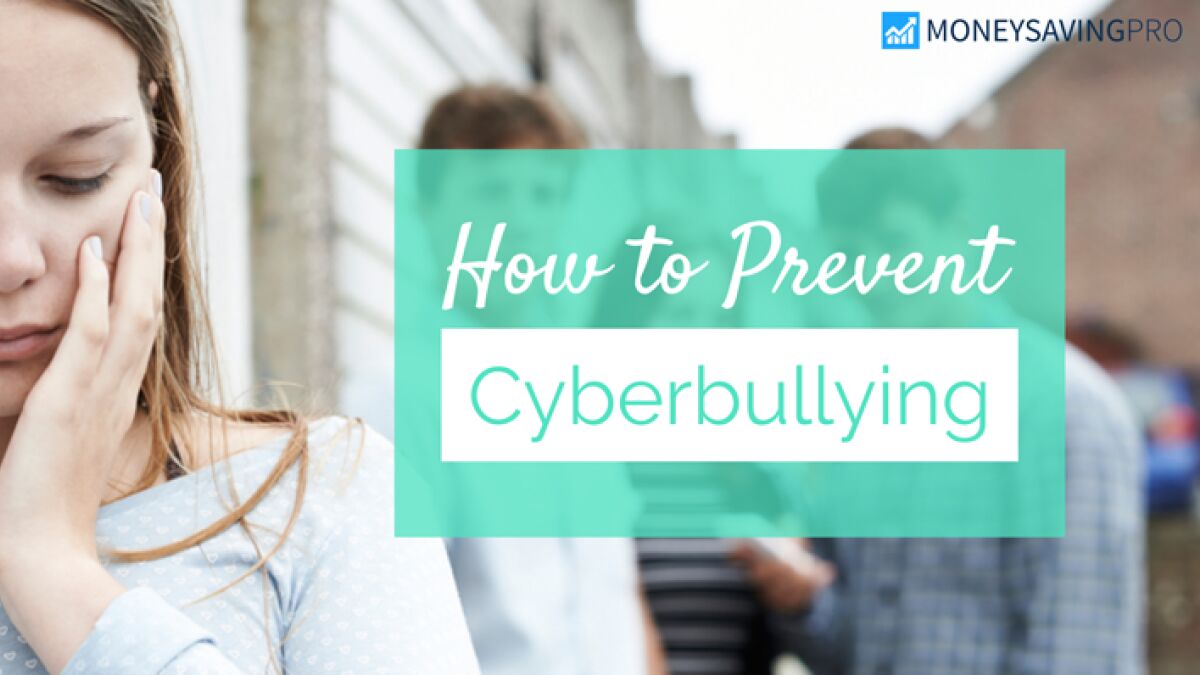
Despite the infinite opportunities the internet offers, there are dangers that lurk in the shadows. And no one is more vulnerable than our children. Bullies now have another venue to harass and abuse people. There's no doubt that bullying has a grave impact on our children. According to the U.S. Department of Justice:
"160,000 kids per day do not attend school for fear of being bullied."
What can we do?
First and foremost, we need to talk to our kids. I'll give you tips on doing so, then walk you through the steps you can take to prevent cyberbullying, how to properly report it, and offer a wealth of additional resources in case you need help beyond the scope of this guide.
Cyberbullying definition
The definition of a bully is someone who uses physical strength or manipulation to harm or intimidate victims. Typically, the effect of bullying is almost certainly negative on the victim.
Now, let's take a moment to clarify. After all, it's important to define cyberbullying so you can fully understand the roots of the term.
The dictionary defines cyberbullying as "the use of electronic communication to bully a person, typically by sending messages of an intimidating or threatening nature."
Cyberbullying happens over electronic devices such as cell phones, tablets, and laptop computers. Such bullying messages are delivered via an e-mail account, text messages, live chat, chat rooms, websites, and social media sites. Mean messages, rumors or posts on social networks, embarrassing photos, videos, fake posts, and profiles all are examples of cyberbullying.
Although cyberbullying may not be as obvious as its physical counterpart, the effects can be just as dangerous to the long-term development of a child.
How is cyberbullying different from regular bullying?
There are several distinct differences that set cyberbullying apart from the normal type, which takes place in person, typically in school. As the U.S. government's Stop Bullying campaign points out, the cyber form of this insidious activity is:
- Persistent: When a child is bullied in school, they can normally at least get away from the pressure once they arrive home. The internet is never at rest. This means that bullying can take place 24 hours per day, seven days per week.
- Permanent: Things posted on the internet seldom go away. These activities can impact the victim - as well as the perpetrator - on a long-term basis. Employment, college admissions, and many other aspects of one's life can suffer negatively from a poor online reputation.
- Hard to Notice: Teachers and parents may see and hear what goes on inside or outside the school. Internet bullying, on the other hand, is often silent. Further, according to DoSomething.org, just 10% of victims tell an adult that they're being bullied online.
It's not always children
Though cyber bullies are likely to be peers that are of similar age to the victim, that may not always be the case. Take, for instance, Megan Meier, a young 13-year-old girl who was cyberbullied by adults - specifically the parents of a former girlfriend of Megan's - posing as a 16-year-old boy named Josh Evans. Horrifically, Megan Meier committed suicide due to an onslaught of insults and shaming - typically aggressive behavior - and the family wasn't charged.
Cyberbullying types
Unfortunately, bullying has been around just about as long as humans have existed. Online bullying, however, is only a couple of decades old.
Cyberbullying takes place over various electronic devices via e-mail accounts, texting, websites, social media, and even online gaming. In addition, cyberbullies employ several types of attacks.
1. Online harassment
A cyberbully typically sends mean messages to a person or group multiple times. The term online harassment implies a pattern of bullying. Cyberstalking is simply one type of online harassment, and victims are of all types, whether they are lesbian, gay, bisexual, or straight.
The signature attribute of online harassment is that it is comprised of ongoing rude attacks over time. At its worst, it culminates in incidents of harassment in the offline world.
2. Cyberstalking
Cyberstalking is online stalking, employing the internet to stalk and harass a person. Cyberstalkers use identity theft, threats, false accusations, monitoring, and more in pursuit of their target. In some cases, cyberstalkers seek to sexually or otherwise exploit minors, crossing the line into criminal activity.
Whatever form the cyberstalking takes, the key element is that it is unwanted and, in many cases, illegal. Whether it's via phone calls, instant messenger, social media, or other devices, if you or your family is subject to an onslaught of unwanted harassment, contact, or attention, it can be defined as cyberstalking.
3. Exclusion
Another form of cyberbullying is exclusion, where a person is purposefully left out of an online group, chat room, or site. Other members of the group sprinkle mean comments about the excluded person and harass them in cyberspace.
4. Outing
When a bully posts personal or private information online about someone publicly, it's called an outing. A bully may post embarrassing pictures, videos, personal texts, emails, or instant messages.
A typical online bully might print or share messages or conversations, including sexual (i.e., outing the victim's lesbian/gay/bisexual sexual orientation) or personal information, making them public by "outing" a person via the internet.
As a result of the "outing," using these embarrassing pictures, videos, and messages, peers may harass the victim.
5. Masquerading
Masquerading is a deceptive type of cyberbullying. The bully creates a fake messaging name or email address or hijacks someone else's online identity to bully a person while pretending to be someone else.
Cyberbullying signs
There are a number of warning signs that a child may be either the victim, the bully, or a witness. These indicators may vary depending on whether you're the child's parent or teacher.
What parents should watch for
Signs that your child may be the victim of a cyberbully include:
- A decrease in willingness to go to school - coming up with more and more reasons not to go
- An increase in anxious, depressed, withdrawn, and/or agitated behavior
- Sadness or anger after using electronic devices and/or decreased usage
- A decrease or increase in sleeping or eating
- A drop in grades
If you notice any of these symptoms in your school-aged child, take action by opening up a discussion about what may be going on in their lives at school and online.
Signs that your child may be a cyberbully:
- Has a history of bullying or being bullied at school
- Is experiencing increased disciplinary issues at school
- Switches screens or otherwise avoids letting you see what they're doing on their devices
- Laughs in an excessive manner while using electronics and won't tell you why
- Has multiple social media or other online accounts
- Becomes disproportionately upset when not able or allowed to use electronic devices
Signs that your child may be a witness or bystander to cyberbullying:
- Unexplained feelings of anger, fear, or guilt
- Feelings of helplessness
- Reluctance to engage in their normal electronic usage
- Upset after using electronics such as their cell phone
What teachers should watch for
Signs that your student may be a victim:
- Becomes a loner when he/she wasn't in the past
- Decreased attendance
- Sudden onset of aggressive behavior
- Dropping grades
- Withdrawal from usual school social activities
- Mood swings, depression, or increased stress
Signs your student may be a cyberbully:
- Has a history of bullying in school
- Has conflicts with other students, particularly those with victim characteristics
- Is the subject of rumors of inappropriate online postings
It's important for teachers to understand that kids who witness cyberbullying often exhibit symptoms similar to those of victims themselves.
Online child safety
Child safety, especially online, is important. As your kids begin to go online on various electronic devices, talk to them about internet child safety. Set the bar high, requiring them to be respectful of others online and act as responsible digital citizens. Monitor their web use to help them avoid cyberbullying and inappropriate content.
Here are some guidelines to teach your kids how to behave appropriately online:
- Keep personal information private and deploy internet safety techniques. This includes passwords, phone numbers, addresses, and gossip. Check out our guide to preventing child identity theft for effective tips and strategies.
- Treat others with respect and practice good digital citizenship. If they disagree with someone online, do so politely. Resources such as CommonSense.org also provide good digital citizenship techniques.
- Stand up for your peers. If a friend or someone your child knows is being bullied, encourage your child to back them up. There is strength in the community of peers.
- Report cyberbullies. Reporting these online bullying behaviors improves the internet for everyone.
- Pay attention to family rules. Set boundaries about what content is acceptable, what websites are not acceptable, and allowable hours for web surfing and texting. Responsible children earn more privileges.
- Take a moment to think before you post, share, or text. Kids, in particular, should pause to consider how they and their audience might feel after they post. You can't always delete, and even if you take down a mean comment, the damage may have been done. Teaching them proper cell phone safety guidelines goes a long way in creating positive online behavior as well.
Most importantly, you should have regular talks with your children (over the dinner table is a good place for low-pressure conversation) about their online activities. Ask them questions like:
- What are your favorite websites? What do you do there?
- Have any of your friends or classmates ever posted anything negative about you?
- Have you ever talked about someone else online in a negative way?
- Does your school offer resources for kids or a way to anonymously report cyberbullies?
- What would you do if you saw one of your friends being bullied online?
It's crucial that you raise these questions in a casual, non-aggressive manner - phrase them as if you are curious, not interrogating. When kids know that you're aware of potential problems, they are more likely to come to you for help if a problem arises.
Conversely, you may be able to prevent your child from becoming a cyberbully if he/she knows that you are paying close attention and that online activities can have serious consequences.
Put it in writing
Dr. Sameer Hinduja is known for his groundbreaking work on both cyberbullying and safe social media use. He is currently providing training to schools, youth organizations, parents, and kids on how to handle cyberbullying.
Dr. Hinduja has designed a Technology Use Contract, which can help encourage responsible online behavior and open communication between parents and children. Having clear-cut guidelines helps kids know exactly what is expected of them in exchange for the privilege of using the internet.
Talking with your child
It's easy to be lulled into a false sense of security if you know your child is not being victimized or acting as the bully. The truth is that research shows that bystanders or witnesses suffer similar effects as victims. As I mentioned earlier, witnesses can experience depression, anxiety, and feelings of guilt and helplessness.
Talking to your children about what to do if they see someone being bullied online empowers them to take action, thus helping them avoid negative feelings as well as helping someone else out of a bad situation.
Follow my tips later in this guide to talk to your child about what they can do - even as a bystander - to fight and prevent cyberbullying.
Tips for Parents
By this point, you may be feeling a bit lost and helpless. You can't stand over your kids every minute of the day. You probably want some combination of knowledge of their activities coupled with respect for their privacy. That can be tricky, but I've got some tips to help you maintain some measure of awareness and control.
What you can do:
- Follow your children on social media
- Keep records of their login information (with the understanding that this is a "just in case" measure)
- Get familiar with current social media sites, apps, and slang
- Set the location and privacy settings on your children's devices
- Learn how to review your child's phone and computer history in case you suspect an issue
Tools you can use:
- OurPact - Schedule use time, block apps, and even manage chores and homework on any device.
- K9 Web Protection - Force SafeSearch, block categories of websites, and generate online activity reports.
- SecureTeen - Filter inappropriate content, monitor social media, log text messages, and much more.
There are dozens of monitoring apps and software programs, both free and paid, to help you keep track of what your child is doing online. The key is finding the one that's age-appropriate for your child with features that are most important to you.
How to stop cyberbullying
What if you become aware of an active cyberbullying situation involving your child, student, or classmate? What if you yourself are the victim?
For parents
- Don't over-react or under-react. Be supportive, and do not tell your kids to brush it off. Do not threaten to take away your child's devices - this will only cause them to want to hide such incidents.
- Document the evidence. Make print-outs of any proof of online harassment, stalking, or threats, and take screenshots with time and date stamps if possible.
- Report activity to law enforcement. In the next section, I will explain the appropriate reporting procedures to take.
- Talk to the school. Specifically, speak to guidance counselors at your child's school so that they can watch for any bullying activity that may be taking place in person.
For teachers
- Be clear on school policy. As part of the team involved in preventing and addressing this problem, you'll want to be familiar with your school's official bullying policies.
- Speak privately with the child. If you notice signs that a student is being cyberbullied, pull them aside and encourage them to share what's happening. Remind them not to instigate retaliation and to keep records of the evidence on their device.
- Speak with the parents. Assure the child's parents that you will help them by facilitating communications between them, the child, and the school.
- Investigate and take action. If possible, address the bullying student and instruct them to take down any offending posts or content.
- Report the activity. Online harassment should be reported to the social media and other sites on which it took place, particularly if the student and parents do not report it.
For students
- Resist the urge to respond. As hard as it is not to reply, a reaction (and attention) is exactly what the bully wants. If you're targeted online, ignore the perpetrator and do not retaliate in kind.
- Block the offender. If the bullying takes place on social media or in another format that allows you to block the person, do so immediately. You can block a phone number to stop harassing text messages as well.
- Tell someone. Whether it's a parent, a school official, or through an anonymous reporting system at school, say something. Adults can't help you if they don't know what's happening.
- Save the proof. Take screenshots of messages, posts, or chats. Begin saving evidence immediately when someone becomes aggressive or attacking in case it becomes more serious over time.
- Speak up for others. If you're a bystander to cyberbullying, let the bully know others are watching and that you won't stay silent in the face of their abuse. Be willing to report the behavior if necessary - you would want others to stand up for you in the same situation.
Report Cyberbullying
Reporting this harmful activity is the key to interrupting the vicious cycle of cyberbullying. This is when the evidence you've saved will come in handy.
Reporting to social media websites and ISPs
Report any cyberbullying to your social media and internet service providers (ISP), as it violates their terms of service.
Take a look at the policies of social network sites with regard to cyberbullying. They describe inappropriate content as well as your options in case of cyberbullying attacks. Also, review your privacy settings so you know how to block users and who is allowed to contact you or see your posts. Always report harassment, stalking, or inappropriate content to social network sites where it happens.
Reporting to schools
The school climate can be seriously disrupted by cyberbullying, where it's often connected to real-time, in-person bullying. Schools appreciate receiving information about cyberbullying to help create cyberbullying prevention and response strategies. Over time, many states have required schools to address cyberbullying officially as part of their anti-bullying program.
Whether you're a parent or a teen, it's important to make someone in the school aware of the damaging behavior of their students. Whether you tell a guidance counselor, the school social worker, or the principal, the important thing is saying something to someone.
When to report cyberbullying to law enforcement
In some situations, cyberbullying is considered a crime and should be reported to the authorities. The laws vary by state. Here are examples of criminal cyberbullying:
- Threats of violence
- Child pornography or sexually explicit photos or messages
- Taking a video or photo of a person in a situation where they would expect privacy
- Hate crimes and stalking
If you're not sure whether an online act is a crime in your location, research your state's laws online or contact local law enforcement with your questions.
Resources for Parents
- Cyberbullying: Hiding Behind the Screen (NLM NIH) - This comprehensive paper from the NLM NIH (National Library of Medicine - National Institutes of Health) illustrates the ever-growing common occurrence of cyberbullying. This paper sheds light on the subject of how to prevent cyberbullying and also details how healthcare professionals can leave a positive impact on victims suffering from this issue.
- Interview with Justin Patchin of Cyberbullying Research Center (Safekids) - ConnectSafely.org co-director Larry Magid spoke with the co-director of the Cyberbullying Research Center, Justin Patchin. Here, you can find some insight into the growing problem of cyberbullying.
- Cyberbullying and Cyberthreats (Nancy Willard) - You can purchase Nancy Willard's Cyberbullying and Cyberthreats resource guide. This guide provides school counselors, administrators, and teachers with the information they need to prevent and respond to cyberbullying incidents.
- Bullying and Cyberbullying (Elizabeth Englander) - This 216-page insightful book, by the founder and director of the Massachusetts Aggression Reduction Center at Bridgewater State University, Elizabeth Englander, discusses the misconceptions behind peer cruelty, bullying, and cyberbullying.
- Cyberbullying (Pew Internet) - This Parents, Teens and Digital Monitoring."
Recap
Both parents and kids can take measures against cyberbullying before it gets off the ground. A good place to start is the privacy settings on computers, tablets, and phones. Research tools you can use to keep your content private on Facebook and other social networking websites. You can control who is able to view your posts and personal information. Check privacy settings on a regular basis to ensure they are up to date.
Speak with the internet service providers in your area to learn how they keep your connection safe. For more information on how to stay safe online, check out our guide to Internet Safety & Online Privacy.
Never reveal personal information online, including your address, date of birth, phone number, school, credit card number, and other key personal details. Don't share passwords; protect them as you would an ATM PIN number or even a house key. As an exception, it's okay for children to share their passwords with their parents. Be sure to exercise these prevention and intervention measures in order to protect your child and to contact either school officials or law enforcement if a cyberbullying issue arises.








